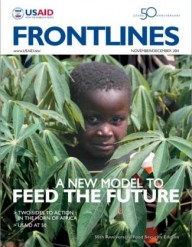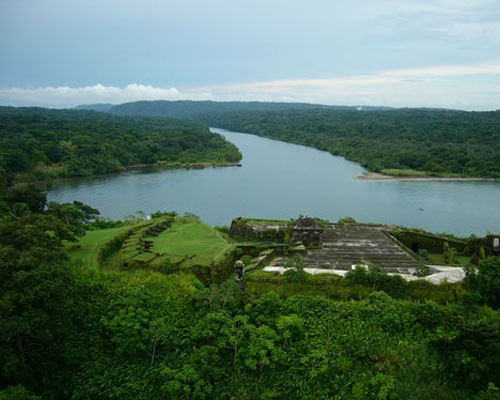 Indigenous communities located at the shore lines of the Gatún River have received technical assistance and training from USAID to help develop sustainable tourism.
CREDIT: USAID
Indigenous communities located at the shore lines of the Gatún River have received technical assistance and training from USAID to help develop sustainable tourism.
CREDIT: USAID
 Indigenous communities located at the shore lines of the Gatún River have received technical assistance and training from USAID to help develop sustainable tourism.
CREDIT: USAID
Indigenous communities located at the shore lines of the Gatún River have received technical assistance and training from USAID to help develop sustainable tourism.
CREDIT: USAID
On the border between Ecuador and Colombia, communities of Cofan Indians are using improved cocoa-production techniques to increase their income as well as to reduce pressure to convert neighboring forests to agricultural lands. Three indigenous groups in this highly biologically diverse region participate in a program with the Government of Ecuador under which they receive annual payments for upholding conservation agreements.
These conservation efforts in Ecuador, supported under USAID’s Initiative for Conservation in the Andean Amazon, are just one example of USAID’s innovative environmental work around the globe. Environmental programs have become one of the larger components of USAID’s portfolio—and a key factor in the design of all projects.
To manage this effort, USAID employs 44 environmental specialists throughout its overseas missions as well as 37 staff in Washington. Of these 81 specialists, 33 were brought in through USAID’s Development Leadership Initiative as budding Foreign Service Officers. For almost 30 years, the American Association for the Advancement of Science (AAAS) fellows have provided invaluable technical support. Additional expertise is provided by in-country environmental specialists as well as experts on loan from other U.S. Government agencies. Well-established federal procedures ensure careful evaluation of potential environmental impacts, and mitigation of negative effects of all USAID’s development efforts.
This was not always the case.
In the early 1970s, environmental issues had not yet taken on their current urgency. USAID had no environmental procedures and no environmental officers. Environmental consciousness was growing, albeit slowly, at home and abroad due to an emergent environmental movement, but it was not yet seen as an integral part of international development work. Then, during a USAID-funded campaign to eradicate malaria in Pakistan, five people died from over-exposure to the insecticide malathion. USAID was sued by a consortium of U.S. environmental groups, which brought the Agency’s environmental impact assessment procedures under scrutiny and sparked action.
In 1977, USAID developed a set of environmental regulations that required it to systematically consider the potential environmental impacts of all its actions. However, this was a new area for the Agency, and was not well understood by its staff. With only a couple of environment officers on its payroll, proactive thinking and planning, as well as enforcement, lagged behind. Says Jane Stanley, who began working at USAID/Panama in 1977 as the mission environment officer: “I got the feeling when I first got this assignment that many in the mission viewed this as a new fad that would go away after a while… that environmental assessments were another pesky box to check off in the project design process.”
For others, genuine concern about the environment was combined with apprehension that new regulations would prove too onerous.
Robert Otto, the Agency’s first regional environment officer in Latin America and Caribbean, found that when he arrived, people were “happy to see me . . . as well as a bit edgy. The edgy part had to do with the prospect that environmental impact issues would stop, or at least delay, most development activities and projects because of the need for lengthy impact analyses. [However], I found that mission project development officers were usually quite concerned about avoiding negative impacts.”
In 1979, Jim Hester—currently the Agency environmental coordinator and director of USAID’s Office of Natural Resources Management—was brought on to help energize a rewrite of the regulations and lead USAID’s efforts to implement them more methodically, creating a system of mandatory assessments of the environmental impact of USAID projects.
These new regulations, known as Regulation 216, helped USAID spot problematic projects early on, and reorient towards more environmentally sound plans.
Hester recalls a proposed project in Peru: “The initial plan was to clear-cut the trees from vast areas of Amazonian rainforest in the eastern part of the country. The thought was that if trees grew so well, then this could become the breadbasket of South America with wide-scale planting of crops in place of trees.”
The environmental impact assessment found the agricultural potential would be minimal and that clearing the land would be an environmental disaster, adversely affecting people who lived in that part of the country. Instead, USAID redesigned the project to use the jungle sustainably as a forest and create incomes that would far exceed what could be earned under the original plan.
Environment as a Factor
After successfully embedding environmental assessments and safeguards into the Agency’s work, the next step was to insert environmental components into existing projects. One such project was a rural development effort in northern Costa Rica, along the border with Nicaragua, in the early 1980s. The effort planned to improve roads, schools, and health clinics as part of a comprehensive plan to address rural poverty and avert destabilization from conflict across the border. However, an assessment predicted that new roads would bring heavy deforestation and more people to the area, among other impacts. Not only did construction need to proceed in an environmentally sound way, but the pristine and ecologically critical Caño Negro river and wetlands, used as a habitat for a range of migratory threatened and endangered species, needed to be protected.
Responding to these concerns, USAID supported the creation of a wildlife refuge to both protect the natural habitat and provide revenues from eco-tourism, creating an incentive for local citizens to support the project. “Today, the Caño Negro reserve is a thriving, though remote, bastion of eco-tourism,” said Hester.
On a much larger scale, efforts in neighboring Panama starting in the late 1970s integrated a host of activities ranging from protection of parks and forest reserves to environmental governance. These efforts responded to a series of ecosystem impacts stemming from deforestation and cattle grazing that potentially jeopardized the operation of the Panama Canal. Bob Jordan was a mission project development officer when he helped design the Panama Canal Watershed Project in 1978. The project was designed to mitigate the impacts through a conservation program that protected 95,000 hectares of natural parks and reserves in the Panama Canal watershed, and provided technical assistance to improve the Government of Panama’s watershed management capacity and increase environmental awareness among citizens.
“It sparked my life-long interest in natural resources management,” said Jordan recently.
One crucial aspect of the program was working with Panama’s Renewable Natural Resources Directorate (RENARE). Although at first RENARE had limited capabilities, with ongoing USAID help it grew into a semi-autonomous institute. Eventually it became a fully autonomous National Environmental Authority with a ministerial-level executive director.
With USAID’s help, RENARE “gained watershed management experience by implementing soil conservation, improved pasture practices, and 4,000 hectares of reforestation,” according to David Bathrick and Bruce Kernan, former USAID officers, in an evaluation report on the project. USAID also helped raise awareness of environmental issues more broadly, leading to a number of locally based environmental NGOs.
USAID’s watershed management work in Panama, which continued over a span of 30 years, not only promoted the creation of protected areas in the Panama Canal Watershed, but also promoted environmental regulations for protection and sustainable management of natural resources; strengthened government institutions; promoted sustainable agriculture and cattle ranching; and developed a watershed governance structure that is a model for decentralization.
Congressional Mandates
Environmental projects weren’t always focused on preserving nature from the influence of people. In Sri Lanka, the tables were turned. In the 1980s, USAID and other donors supported a large irrigation and rural development program in the Mahaweli Ganga basin. An environmental assessment of the project indicated that elephants, deprived of their natural habitat, would threaten local populations and their crops by straying into agricultural areas. Working with the Sri Lankan Parks and Wildlife Department, USAID supported an effort to create national parks, and corridors connecting them, to accommodate elephant movements. The aim was to preserve habitats of both the elephants and the local citizens.
As implementation of environmental work surged in the field, safeguards continued to be codified in Washington. In the 1980s, Congress passed regulations requiring environmental impact assessment, and conservation of tropical forests and biodiversity. This legislative action spurred further proactive attempts to address environmental issues.
To meet the congressionally mandated requirements, USAID ramped up its technical staff. By the mid-1980s, 10 environmental officers were located in field offices throughout the world and in Washington. In 1982, Hester, along with USAID Science Adviser Howard Minners, initiated USAID participation in the AAAS program to attract highly qualified scientists to work on environment and science.
USAID’s diverse history of environmental work has led to a natural-resource management approach that not only takes into account natural resources such as water, forests, and land, but also economic growth and good governance. USAID’s Mike McGahuey, who has worked on natural resources management issues in Africa for more than 30 years, highlights the importance of such an approach: “In the African Sahel in the 1970s, project-driven reforestation efforts were aimed at conservation and the results were poor. In contrast, over the last 25 years, farmer-managed natural regeneration of on-farm trees has grown from a few thousand hectares to over 5 million hectares in the Sahel and continues to expand. Driving this expansion were increased crop yields and greater resilience to climatic variability. But, in addition to these economic drivers were changes in the forest codes that conveyed forest management authority and responsibility from the state to farmers and communities. These two factors—economic incentives and local control over resources—were critical to successes.”
With global climate change an increasing concern, USAID is also considering how its activities affect greenhouse gas emissions and the impacts that a changing climate is already having (and will continue to have) on the globe and on USAID’s work. To that end, the Agency plans to release a new Climate Change and Development Strategy that provides guidance and a roadmap for USAID’s climate change work, including integration of climate considerations across its development portfolio.
Today USAID takes an integrated approach to natural resources management. Land and water must be managed skillfully so they are able to produce food for the world’s growing population. Water quality must be maintained and improved to keep populations healthy. Forests must be maintained by people who live in and near them, and depend upon them for their livelihoods. If decades ago the environment was not yet seen as an integral part of international development work, today, at 50, the Agency is that much wiser for its years.











Comment
Make a general inquiry or suggest an improvement.